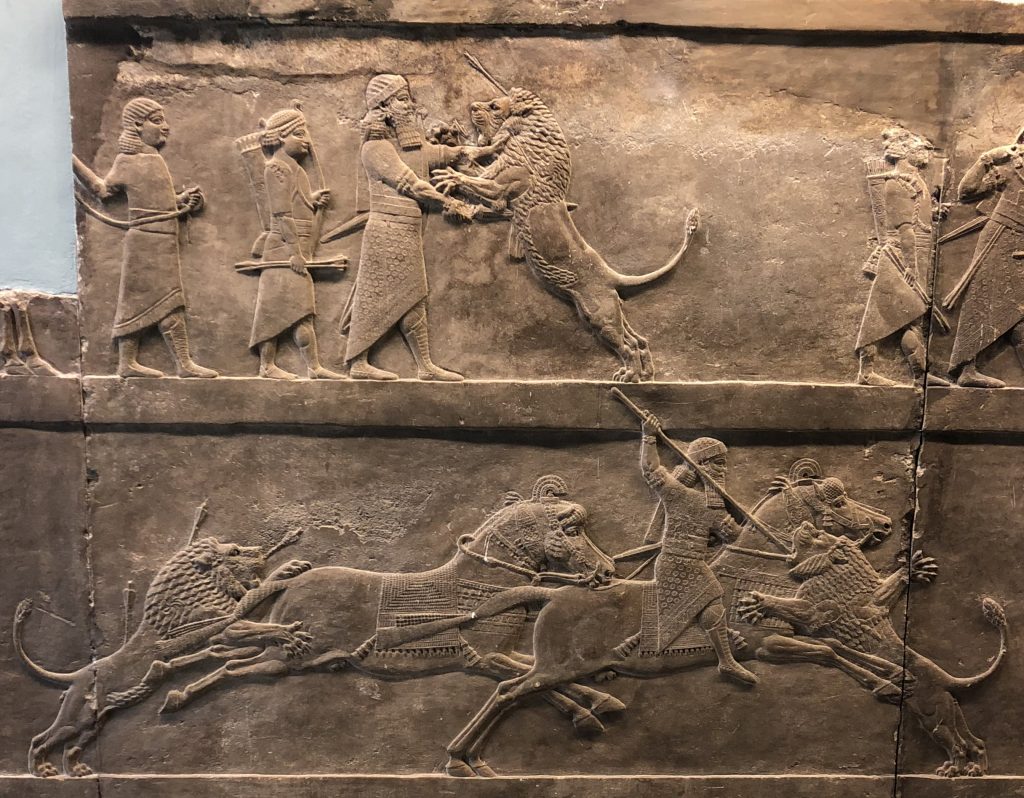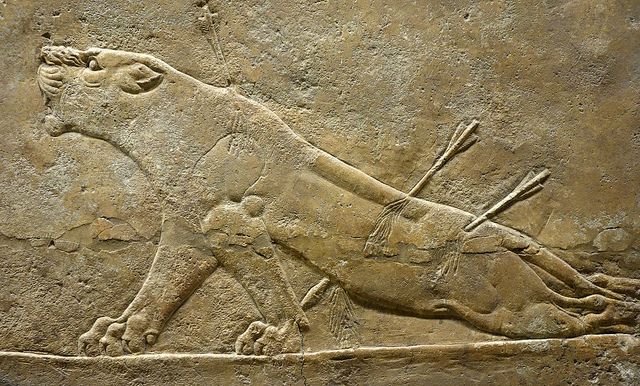Asur ortostat kabartmaları II. Aşurnasipal saltanatından (MÖ 883-859) Asurbanipal saltanatına (MÖ 669-626) tarihlenmektedir. Bilinen ilk örnekler şu anda British Museum’da sergilenen Nemrud Sarayı’nın taht odasında. Bazıları 2 metreden daha yüksek bir yüksekliğe sahip alçı panellerdir, bunların çoğu büyük figürlerle oyulmuştur, bunların çoğu yatay bir merkezi bantla iki parçaya bölünmüştür. Bu bloklar, heykeltraşlara, kralın, sahnelerin kesintisiz olarak birbirini takip ettiği askeri keşiflerini kaybedebileceği muazzam uzunlukta şeritler sağladı.
Aynı sistem daha sonraki saraylarda da benimsenmiş ve ana fikir pek değişmemiştir. Genellikle amansız bir şiddet hikayesi, art arda şehirlerin kuşatılması, baskına uğratılması ve yağmalanması katledilen veya esarete sürüklenen esirler, aslanlar ve boğaların öldürülmesiyle meşgul krallar. Binlerce figür olağanüstü çeşitlilik ve hayatiyet içindedir. Temsil ettikleri teknikleri de iki yüz elli yıllık süre boyunca daima yenilenmemiştir ve en eski rölyeflerde bile Mezopotamya ve eski Mısır geleneklerinden önemli ölçüde ayrılıklar görülür. Asur kralları da askerlerinden ve hatta düşmanlarından bile daha büyük değildir. Boyutlardaki farklılık rütbeyi belirlemez
III. Tiglath-Pileser (M.Ö. 745-727 ) için yontulan ortostatlarda figürlerin mekanda gerçeğe çok yakın yansıtılması başarılmıştır. Bunlardan bir tanesi ikinci krallar kitabına göre Şalmaneser’in ‘’ İsrail’i Asur’a sürgün etmesi ‘’gibi fethedilmiş bir şehrin halkının başka bir yere yerleştirmek üzere götürülmesini gösterir..
Asur Sanatı
En etkileyici Asur kabartmaları, figürlerini Mısır heykellerinden çok daha geniş bir aralıkta tek bir düzlemde gösteriyor, havanın bedenlerin etrafında dolaştığı izlenimini yaratıyor, detaylara daha fazla dikkat ediyor ve doğal bir tarzda yorumlanan figürlerde bir drama duygusu yaratıyor. Asurbanipal’ın aslanları öldürme sahnesi belki de en güzelidir. Arkasında ölü ve hayat veren hayvanlara bakarken o hızla chariot ile araba geçerken bir panel Kral gösterir. Lioness şüphesiz, okları vücuduna sıkışmış, arka bacaklarını acı ile sürükleyen ve sürükleyen lioness portallarının en güzel örneklerinden biridir. Asur sanatçılarının bu duyguları paylaştığı için bugün izleyicilerde uyandırılan acıma hissi bir yanlış anlaşılmaya neden olmamalıdır. Öte yandan, bir drama sahnesini yansıttıkları bilincine sahip oldukları kesindir. Hayvanlar kesinlikle kızgın değil, bazı sahnelerde hayvan ve insan arasında eşit olarak dağıtıldığı görülüyor,ancak kralın cesaretinin ön plana çıkması için bu tür sahnelerin olması gerekiyordu.

Asurlular M. Ö. onüçüncü yüzyılda bile, aksiyon serilerini tek bir resim alanına yoğunlaştırmayı başardılar. Daha önce, Minos ve Helladik sanatçıları ardışık hareketlerde zaman zaman tekil figürler göstermişlerdi. Ancak, M. Ö. Yedinci yüzyılın Asur heykeltraşları bu tekniği çok daha ileri taşıdı. Nineveh’deki Asurbanipal için bir rahatlama bunun en belirgin örneklerinden biridir. Kabartmada kafesinden salınan bir aslan, ileri atlarken bir okla vurularak düşmanına karşı umutsuz bir hamle yapar. Kral ve kalkanı taşıyan arkadaşı figürleri anlatımda birbirinden ayrılmış iki sahnede gösterilmiştir.
Kabartmayı doğru okumak için üç ardışık bölümü zihinsel olarak ayırmak gerekir. Bununla birlikte, kafesin kapısını kaldıran ve hırlayan aslanın, bekçiden ayrılma anında aksiyon heyecanını yaşamak için böyle bir çabaya ihtiyacı yoktur. Hayvan, son derece keskin bir gözlem gücü, ağırlığı ve kas gücü ile kürkünün dokusu ile yansıtılır. Resimli Anlatım sanatının zirveye getirildiği bu harika kabartmaların, Gılgamış Destanı da dahil olmak üzere Mezopotamya edebiyatının ana eserlerinin korunduğu çivi yazısı tablet kütüphanesinin sahibi Asurbanipal için inşa edilmesi belki de önemlidir. Bu kabartmaların neredeyse tamamı boyandı. Dekore ettikleri saraylar, zenginlikleri için uygun süslemeler ve eşyalar gösteriyordu ve sadece bir kısmı korunabilirdi.
Ortostat nedir?
Antik Mezopotamya’da, özellikle Asur ve Hitit mimarilerinde, binanın zemininin üzerinde bulunan ve olağanüstü boyutlara sahip süslü bir duvar ve kaldırım taşıdır. Terim, birçok kültürün mimarisinin tanımında kullanılmak üzere genelleştirilmiştir. Hitit ve Asur heykellerinde, ortostatlar genellikle karmaşıklıktan oyulur, ancak genellikle megalitik kökenli olan dik duran taşlarda kullanılabilir.
Assyrian orthostat reliefs are dated from the reign of Ashurnasipal (883-859 BC) to the reign of Asurbanipal (669-626 BC). The first known examples are in the throne room of the Nimrud palace, which is now on display at the British Museum. Some of them are gypsum panels with a height of more than 2 meters, most of which are carved with large figures, most of which are divided into two parts by a horizontal central band. These blocks provided the sculptors with enormous length strips that the king could lose their military expeditions, where the scenes follow each other without interruption.
The same system was adopted in later palaces and the main idea has not changed much. Usually a relentless story of violence, kings captured by the siege, raiding and looting of cities in succession, or captured by captivity, kings engaged in the killing of lions and bulls. Thousands of figures are of extraordinary variety and vitality. The techniques they represent have not always been renewed for a period of two hundred and fifty years, and even in the oldest reliefs there are considerable differences from Mesopotamian and ancient Egyptian traditions. Assyrian kings are no bigger than their soldiers and even their enemies. The difference in dimensions does not determine the rank.
III. In the orthostats carved for Tiglath-Pileser (745-727 BC), it was achieved to reflect the figures very close to reality in the space. One of them shows that according to the second kings book, the people of a conquered city like Shalmaneser ” exile Israel to Assyria ” were taken to be placed in another place.
Assyrian Art
The most impressive Assyrian reliefs show their figures in a single plane with a much wider range than the Egyptian sculptures, creating the impression that air is circulating around the bodies, paying more attention to detail and creating a sense of drama in figures interpreted in a natural style. Asurbanipal’s scene of killing lions is perhaps the most beautiful. A panel shows the king as he quickly passes through the chariot with the chariot while looking at the dead and life-giving animals behind him. The lioness is undoubtedly one of the most beautiful examples of the lioness portals, whose arrows are stuck in her body, dying and dragging her hind legs with pain. The feeling of pity aroused in the audience today should not cause a misunderstanding as the Assyrian artists share these feelings. On the other hand, it is certain that they have the consciousness that they have reflected a drama scene. The animals are definitely not angry, it seems that in some scenes it is distributed equally between the animal and the human, but it was probably necessary to have such scenes in order for the king’s prowess to come to the fore.
Assyrians BC Even in the thirteenth century, they managed to concentrate the action series in a single painting area. Previously, Minos and Helladik artists had shown singular figures from time to time in successive movements. However, BC. Assyrian sculptors of the seventh century carried this technique much further. A relief for Asurbanipal in Nineveh is one of the most obvious examples of this. A lion released from his cage in the relief makes a desperate move against his enemy, shot by an arrow while jumping forward. The figures of the king and his companion carrying the shield are shown in two scenes separated from each other in the narration.
It is necessary to mentally separate three consecutive sections to read the relief correctly. However, the lion who lifts the door of the cage and snarls does not need such an effort to experience the action excitement at the moment of leaving the guard. The animal is reflected with an extremely sharp observation power, weight and muscle strength, as well as the texture of its fur. It is perhaps important that these wonderful reliefs, in which the art of illustrated narration was brought to the top, were built for Asurbanipal, the owner of the cuneiform tablet library, where the main works of Mesopotamian literature, including the Epic of Gilgamesh, were preserved. Almost all of these reliefs were painted. The palaces they decorated also had illustrated decorations and items suitable for their wealth, and only some of them could be preserved.
What is orthostat?
In ancient Mesopotamia, especially in Assyrian and Hittite architectures, it is a decorated wall and paving stone that is above the floor nivos of the building and has extraordinary dimensions. The term is generalized for use in the description of the architecture of many cultures. In Hittite and Assyrian sculptures, orthostats are often carved out of complexity, but can be used in upright standing stones, generally containing megalithic origin.

